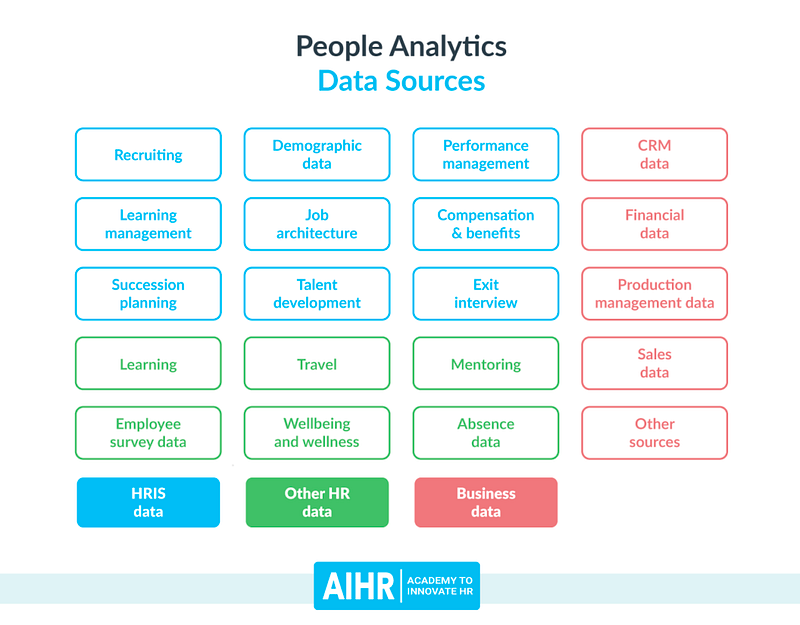In the past, Human Resources always felt a little bureaucratic to many businesspeople. It was all about compliance and rules, rather than adding value to the company. Just look at the way Toby, the HR rep, is portrayed in the TV show The Office – he’s little more than a butt of jokes, and a thorn in the side of the rest of the team.
But all that is changing. HR is becoming more data-driven, using analytics to understand how people work and how they can be better managed and motivated. This is known as ‘people analytics’; it goes far beyond the simple tracking of employee hours and vacation days.
People analytics involves the collation and analysis of data on employee performance, CRM, mentoring, wellbeing, skills development, and much more. Using this data, HR professionals can optimize the workforce, improving productivity and reducing costs.
In this article, we’ll explore people analytics in more detail. We’ll look at the following:
- What is people analytics?
- How does people analytics work?
- What benefits do people analytics bring to businesses?
- Common pitfalls of people analytics and how to avoid them
Ready? Let’s go!
What is people analytics?
If the concept of people analytics is new to you, you may be wondering – where has this term come from? Is it just a passing trend, or is there something more to it?
Simply put, people analytics is the application of data-driven techniques and methodologies to the study of human behavior within an organization. And it’s not a niche tucked away in the corner of some obscure research lab – it’s a growing field with real-world implications for organizations of all sizes.
In recent years, businesses have come to realize that there is tremendous value in analyzing data related to their employees. The vast majority of businesses now have a people analytics team that is even more specialized than HR. Not only that, but those businesses cite people analytics as a critical factor in their ability to compete and grow.

So, what are some of the key areas where people analytics can be applied? Let’s take a look:
- Recruiting and hiring
- Employee retention and turnover
- Workforce planning and forecasting
- Learning and development
- Employee engagement and motivation
- Organizational design
Of course, some of these are already taken care of through traditional HR analytics methods. But where HR and people analytics differ, however, is in the use of cutting-edge techniques and planning tools to mine data for new insights.
People analytics vs HR analytics
People analytics teams are now using big data techniques such as machine learning, natural language processing, and predictive modeling to gain a deeper understanding of human behavior within organizations. This allows them to identify patterns and correlations that would be otherwise impossible to detect.
The goal of people analytics is to use this data to improve business outcomes such as employee productivity, organizational efficiency, and even customer satisfaction. However, it’s important to note that the benefits of people analytics are not always easy to measure.
That said, there is a growing body of evidence that shows how people analytics can help organizations achieve their goals.
This is because people analytics takes a more holistic approach; it doesn’t simply look at attendance or turnover rates, for example. It considers all aspects of employee behavior alongside other company data, like sales, professional development, employee satisfaction, and more.
The bottom line is that people analytics is here to stay, and businesses that don’t embrace it will be at a disadvantage. The key is to find the right team of experts who can help you harness the power of data to improve your organization’s performance.
How does people analytics work?
Now that you know what people analytics is, it’s important to understand how it works. You’ll be surprised at how sophisticated the process has become. Let’s take a look at the key components.
Data acquisition
The first step of any people analytics team is collecting big data. These teams emphasize the importance of data gathering and mining to find the right insights. They use a variety of techniques, including surveys, interviews, focus groups, text analytics, social media monitoring, and web scraping.

According to the Academy to Innovate HR, there are several key sources of data that people analytics teams should focus on:
- Employee performance data (HR metrics, engagement surveys, and customer satisfaction surveys)
- Demographic data (age, sex, location, and job role)
- Behavioral data (email activity, social media activity, and call center logs)
- Financial data (sales, profits, and expenses)
- Learning management system data (course completions, grades, and certifications)
- Succession planning data (position openings, employee development, and competency assessments)
- Recruitment data (application submissions, interview processes, and job offer acceptance rates)
- Sales data (customer profile data, lead conversion rates, and deal sizes)
- CRM data (customer service interactions, support tickets, and product usage data)
- Absence and attendance data
- Data gathered from exit interviews
- Employee survey data (collected anonymously)
- Travel data (location, frequency, and purpose)
- Mentoring data (who is mentoring whom and how often, outcomes and relationships)
- And more

Of course, this is an extensive list, and not all data is captured by every organization. However, the goal is to capture as much relevant data as possible in order to gain a holistic view of employee performance.
Collecting the data
In order to get a comprehensive view of employee performance, it’s important to capture the above areas of data as accurately as possible. However, data acquisition can be a daunting task.
It’s not as simple as gathering email addresses or social media handles; you need to capture the right data at the right time in order to make accurate insights. So, how is this done?
Luckily, there are software programs for everything these days. Here are some of the most popular tools used for people analytics:
ChartHop: Helps you to visualize employee data and track employee engagement over time.
Lattice: Focuses on company culture data and helps you to identify employee engagement and productivity drivers.
OrgValue: Combines people data with business data for a more holistic view of employee performance.
Sisense: Helps with hiring, attrition, attendance, and other people data analytics.
Tableau: A data visualization tool that can be used for simpler people analytics.
There are many other tools available, but the ones listed above are some of the most popular. It’s important to find the right tool for your organization and make sure that it can capture all the relevant data.
Data analysis and interpretation
Once the data is collected, it needs to be analyzed and interpreted. This is where people analytics teams really shine. They are experts at taking data and turning it into insights that can be used to improve employee performance.
The data analysis process usually follows these steps:
1. Goals are identified
It’s crucial for teams to begin by clarifying exactly what they are hoping to glean from the data. What questions need to be answered in order to improve employee performance? Are you looking to optimize recruitment and retention? Identify high-performing employees? Understand what motivates employees?
2. The data is sorted and cleaned
This involves removing any irrelevant data and organizing the data in a way that makes it easy to analyze. If using software to do this, people analytics teams will often create custom algorithms to help them find insights more quickly.

3. Patterns and trends are identified
Once the data is sorted and cleaned, it’s analyzed for patterns and trends. This is where the team’s expertise in data interpretation comes in handy. They need to be able to identify what the data is telling them and how it can be used to improve employee performance.
4. Insights are generated
Patterns and trends that are identified during the data analysis process are turned into insights. These insights can be used to make changes in how employees are managed, how the organization is structured, or even how it markets itself to potential employees.
5. Results are communicated to stakeholders
People analysts cannot make significant change without buy-in from stakeholders, and as such, they need to be able to communicate the findings of their analysis in a way that is easy to understand and will help stakeholders see the value in people analytics.
6. Changes are implemented, and the cycle begins anew
When the insights generated from data analysis have been put into action, it’s important to track how they impact employee performance. If changes are successful, the team will continue to analyze data and generate new insights in order to improve employee performance even further.
So, there you have it – that’s what people analytics is all about. It’s the process of turning data into insights that can be used to optimize your company. And while it’s not always easy, it can be incredibly rewarding for everyone involved.
What benefits do people analytics bring to businesses?
With such an extensive and involved process, it’s understandable to be wondering what benefits people analytics bring to businesses. The advantages are plentiful and can be grouped into three major categories: organizational, strategic, and operational.
Organizational benefits
On an organizational level, there are immense benefits to people analytics. To begin with, it creates a structure for data collection and analysis – one that helps organizations better understand their employees and how they work.
Additionally, it enables organizations to identify and track employee engagement and motivation, as well as succession planning. People analytics can also help with organizational design, by identifying the most effective team structures and job roles.
Strategic benefits
People analytics provides a valuable strategic perspective for businesses. By analyzing data on employee productivity, turnover, and other factors, managers can develop a detailed understanding of what is driving success (or failure) in their organization.
This information can then be used to make informed decisions about where to focus resources – for example, by allocating more training budget to departments that are struggling or hiring new staff for areas of the business that are growing rapidly.

Operational benefits
Through people analytics, you can access a wealth of operational benefits. Perhaps most importantly, it can help businesses to cut costs by reducing employee turnover and improving productivity.
It can also help to improve customer service, as businesses can use data on employee engagement and motivation to ensure that their staff are providing the best possible service. Finally, people analytics can also be used to improve safety and compliance in the workplace.
By no means is people analytics a mandatory process – but the benefits it brings to businesses are clear. When undertaken correctly, it can help organizations identify and capitalize on opportunities, improve employee productivity and satisfaction, and make better strategic decisions.
Common pitfalls of people analytics and how to avoid them
It’s important to note that people analytics doesn’t always go as planned. You’re dealing with large amounts of data from many sources, so making sure everything is accurate and aligned can be difficult.
Let’s run through some of the most common pitfalls of people analytics, and what you can do to avoid them:
1. Not having a clear objective.
This is perhaps the biggest mistake you can make when embarking on a people analytics project. It’s like any complex project – if you don’t have a specific goal in mind, you’re going to struggle to achieve anything.
When it comes to people analytics, make sure you know what you want to find out before you start collecting data. This could be anything from employee engagement levels to the effectiveness of your recruitment process.
2. Not having a good data governance process in place.
A good data governance process or software ensures that all data is of high quality and is properly aligned with your objectives. Without this, you’re likely to end up with a lot of inaccurate data which will only muddy the waters when it comes to analysis.
3. Not using the right tools and techniques.
There are a number of different tools and techniques at your disposal when carrying out people analytics. Make sure you use the right ones for the job – this could be anything from data mining to text analytics.
Attempting to manually analyze large amounts of data is a recipe for disaster, so make sure you have the right tools in place to help you.

4. Not getting buy-in from key stakeholders.
People analytics can be a complex and time-consuming process. The last thing you want is for key stakeholders to lose interest or become disengaged.
Make sure you get buy-in from key stakeholders early on in the project and keep them up to date with how things are progressing. This will help to ensure that everyone is on the same page and that the project stays on track.
5. Not communicating the findings effectively.
Once you’ve completed your people analytics project, you arrive at the all-important task of communicating the findings. It can be a difficult process, as you need to make sure you communicate them in a way that’s easy to understand for non-experts.
Take the time to craft a clear and concise report, and ensure you hold presentations for key stakeholders to help them understand the findings in more detail.
People analytics can be messy – but with the right tools and techniques, you can avoid these common pitfalls and get the most out of your data.
Final thoughts
In business, it is crucial to continually optimize and improve performance. To do so, you need people analytics – the process of turning data into insights about people.
Hopefully, this article has given you a good understanding of what people analytics is, what it can do for your business, and the different ways to use it.
There’s no doubt that people analytics is growing in importance, so make sure you start implementing it in your organization as soon as possible!
